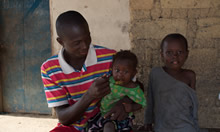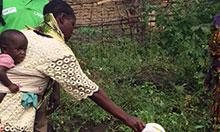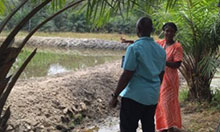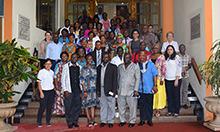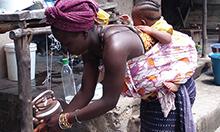Executive Summary
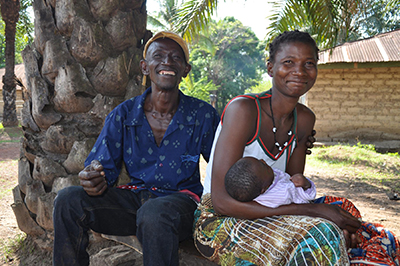
The SPRING project began working in Sierra Leone in January 2016 through funding from the USAID Bureau for Food Security (BFS). During the fall of 2015, BFS requested that SPRING conduct a nutrition assessment to inform Feed the Future investments in nutrition-specific and nutrition-sensitive actions that would complement other donor and government investments, with an overall goal of reducing stunting among children under two years of age and anemia among women and children.
From this assessment, SPRING found the situation in Sierra Leone to be one of low-productivity agriculture, poor health services, limited availability and access to nutritious food, inadequate infant and young child feeding practices, and poor understanding of the contributors to and consequences of poor nutrition. The assessment also found a number of opportunities for strengthening nutrition in Sierra Leone and in the Feed the Future zone of influence, especially in the district of Tonkolili. These opportunities included increasing understanding and prioritization of nutrition by local government and stakeholders, as well as by a range of international and local organizations already working to support agriculture and nutrition services in the area.
Following these findings, BFS provided funding for the 2016 fiscal year, which allowed SPRING to begin testing small-scale approaches for improving dietary diversity and documenting learning to inform longer-term programming. Given the short timeframe, SPRING placed an emphasis on maximizing opportunities for collaboration, learning, and adaptation during the initial implementation period. Working through Helen Keller International, a SPRING partner agency with an established presence in Sierra Leone, SPRING tested several approaches for increasing demand for and consumption of diverse, nutrient-rich foods at the household level, as well as increasing access to and quality of nutrition-sensitive agricultural services.
Beginning in FY17, SPRING used activities and lessons from the pilot phase to support the Entrepreneurial Agriculture for Improved Nutrition (EAIN) project, a USAID-funded Feed the Future activity consisting of a consortium of partners working to improve agricultural productivity and food security Tonkolili. SPRING provided technical assistance and direct engagement to the consortium, with a focus on nutrition-sensitive agriculture and social and behavior change programming.
SPRING in Sierra Leone
Background
Despite increased donor attention, particularly in the wake of the recent Ebola crisis, Sierra Leone remains one of the poorest and least-developed countries in the world. This continued poverty has significantly contributed to malnutrition and stunting among the country’s most-vulnerable population: its children. As of 2014, 76 percent of children 6 to 59 months of age were anemic and 29 percent were stunted.1 In Tonkolili District, where SPRING works, stunting increased between 2010 and 2014 from 332 to 413 percent.
SPRING Goals and Objectives
The goal of the SPRING/Sierra Leone project was to contribute to improving dietary diversity among households with pregnant and lactating women (PLW) and children under the age of two years (1,000-day households) in the SPRING target areas. SPRING’s strategic objective was to improve collaboration, learning, and adaptation related to social and behavior change communication (SBCC) approaches for maternal, infant, and young child nutrition (MIYCN) and nutrition-sensitive agricultural practices. SPRING supported this strategic objective by means of two intermediate results (IR): IR1 Approaches tested for increasing demand for and consumption of diverse nutrient-rich foods at the household level; and IR2 Approaches tested and supported for increasing access to and quality of nutrition-sensitive agricultural services. SPRING aimed to achieve these two results by exploring ways to improve household-level nutrition and hygiene practices, and working with partners to identify opportunities for nutrition within key agricultural value chains.
Figure 1: Results Framework
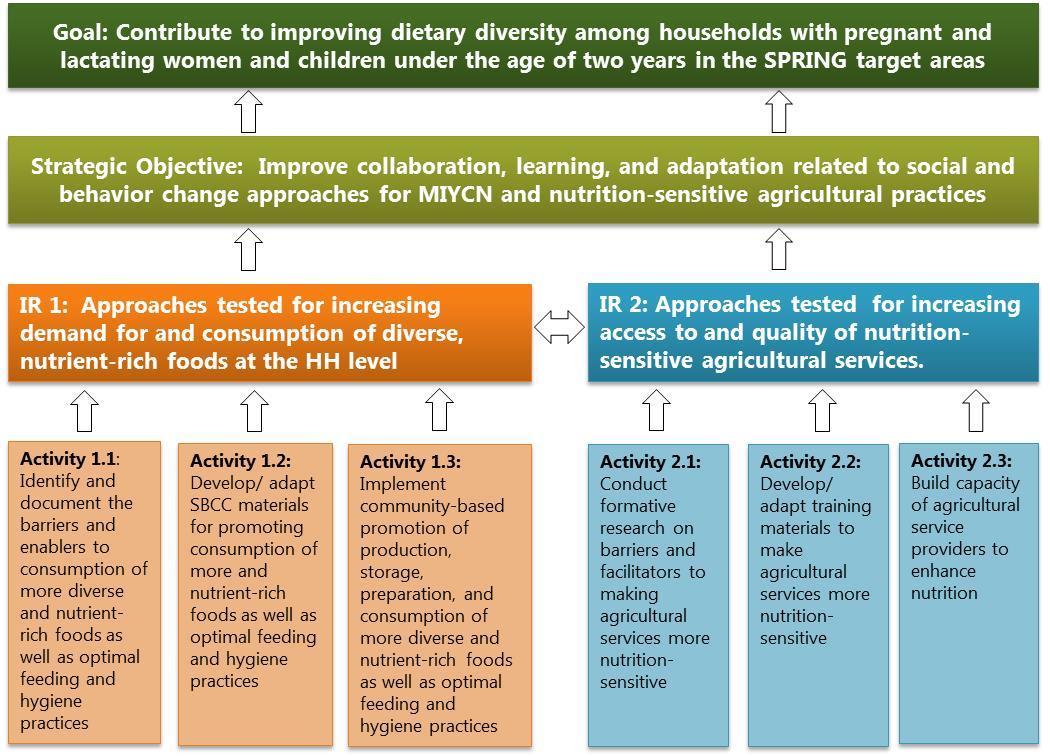
SPRING Intervention Area
Based on discussions with USAID in Sierra Leone and the recommendations from the nutrition assessment conducted in FY15, SPRING decided to focus its activities in Tonkolili District. In FY17, SPRING continued to work in Tonkolili District in support of the Entrepreneurial Agriculture for Improved Nutrition (EAIN) project.
SPRING intervention Area in Sierra Leone
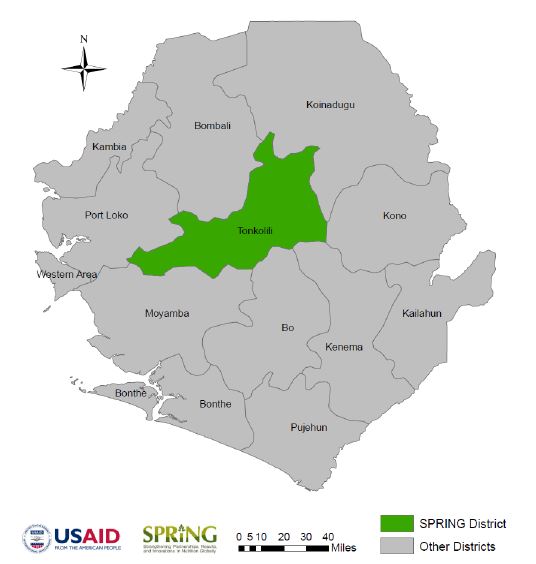
Major Accomplishments
SPRING’s major accomplishments in Sierra Leone fall into two categories: social and behavior change communication (SBCC) and nutrition-sensitive agriculture. These approaches inform and reinforce one another. The majority of the rural population in Tonkolili works in agriculture yet most households eat diets that lack diversity and focus largely on staple foods. The challenge was to promote the uptake of improved nutrition-related household practices and to increase access to high-quality diets and use of health and hygiene services through nutrition-sensitive agricultural interventions.
To address this challenge, SPRING developed a hybrid formative research approach combining traditional agriculture Extension Advisory Services (EAS) and nutrition-based social and behavior change (SBC) tools to inform a holistic response to this nutrition crisis. Health programs commonly use formative research tools such as barrier analysis and trials of improved practices (TIPs) to identify barriers and enablers to the adoption of improved household-level nutrition practices. SPRING adapted these tools to include nutrition-sensitive agriculture and hygiene practices to identify factors related to the accessibility of targeted foods and reducing environmental enteropathy. Extension Advisory Services often use an agricultural value chain assessment to identify constraints to increasing income and yields. SPRING adjusted a commonly-used value chain assessment tool to identify constraints and opportunities to improving supply and quality of vitamin A-rich and animal-source foods (deficient in the diet of the target population), as well as barriers to adopting agriculture practices that have positive impacts on women’s time, energy, and income control. SPRING used the revised tools to assess 506 agriculture actors and PLW in Tonkolili District.
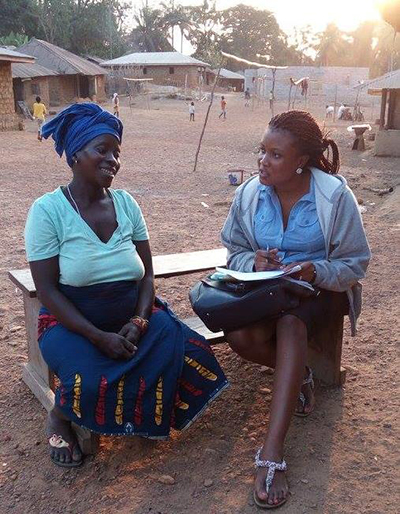
These merged formative research tools provided unique information on the intersection of both the agriculture system and household-level nutrition behaviors that would not have been found using the traditional agriculture and health tools separately. Informed by these findings, SPRING worked with partners and the Ministry of Health (MOH) to develop household counseling materials to promote the consumption of locally available nutritious foods. SPRING also worked with the Ministry of Agriculture, Forestry, and Food Security (MAFFS) to develop and produce counseling cards and posters for market actors to increase production and consumption of vitamin A-rich foods, and to improve the hygiene of animal-source foods in local markets. MOH provided the nutrition counseling cards and training to health workers in Tonkolili, who have incorporated them into their routine work. MAFFS provided the agriculture materials as part of the training of district-level agriculture staff and officers of agriculture business centers (ABCs) and farmer-based organizations (FBOs). The use of the nutrition counseling cards and the agriculture materials have been incorporated into the SBCC strategy used by EAIN partners.
Social and Behavior Change Communication
SPRING began its work in Sierra Leone by conducting a nutrition assessment during the fall of 2015 at the request of BFS. This helped to inform the broader Feed the Future investments regarding ways to reduce stunting among children under two years of age and anemia among women. The nutrition assessment identified dietary diversity, hygiene, and infant and young child feeding practices as areas in need of major improvement. SPRING focused on laying the groundwork for rolling out effective behavior change strategies to encourage uptake of improved nutrition-related practices among households with pregnant women and young children.
In addition, SPRING conducted formative research that yielded insight into how and why families adopt (or choose not to adopt) healthy and nutritious behaviors. SPRING conducted a barrier analysis that examined MIYCN and agriculture practices related to fish and pumpkin consumption by pregnant women and children ages 6–23 months. This demonstrated that the barrier analysis approach, which has traditionally been used to explore health behaviors, can also be used to assess nutritious value chains. The barrier analysis identified strong differences between “doers” (those who "do" the desired practice) versus “non-doers” (those who have not adopted the practice). Among the findings, the team discovered that pumpkin (a vitamin A-rich food) was not only plentiful in the rainy season, but also popular. However, scarcity limited year-round consumption by both pregnant women and children under two. Based on these findings, SPRING determined that we should increase nutrition-sensitive agriculture knowledge and skills on growing and storing pumpkin in the off season, as well as nutrition-specific practices related to household consumption of pumpkin by PLW and children 6–23 months.
The barrier analysis also provided some interesting findings about the consumption of fish. Although fish is popular and widely consumed, the total quantity consumed per person is low. Limited access, availability, and affordability of the preferred varieties of fish, along with poor quality, were the biggest barriers to daily and year-round fish consumption. One of the most important barriers to fish consumption (particularly by pregnant women and children) related to fish hygiene. Many mothers expressed fear about giving their children fish because of the poor quality and/or improper handling of traders. This information helped SPRING to develop SBCC tools, including a fish poster targeting fish market sellers, to improve the hygiene of fish sold, as well as materials educating mothers on how to identify hygienic fish in the market.
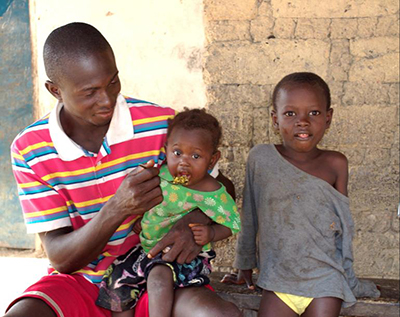
SPRING also conducted a trial of improved practices (TIPs) to pretest practices at the household level and identify which practices should be promoted through SBCC programming. The TIPs provided in-depth understanding of families' preferences and capabilities, as well as the barriers and enablers that they encountered in trying new behaviors and practices related to feeding pumpkin to children, handwashing with soap, and keeping children away from feces.
The rich data obtained during household visits from the TIPs assessment played a key role in refining the choices of SPRING’s SBCC content. For example, building/using tippy taps and liquid soap were accepted much more enthusiastically than expected. As a result, SPRING developed four different counseling cards on handwashing with soap: critical times to wash, building a tippy tap, creating liquid soap, and steps for proper handwashing.
Combining these assessments in a comprehensive, harmonized way was a unique approach to developing an SBCC strategy, and allowed SPRING to create stronger and more relevant behavior change materials for Sierra Leone. Using these findings, the team developed a behavior change framework and key messages for each recommended practice, which helped to guide programming in FY17.
Sharing Lessons Learned
In FY17, SPRING led a cross-border trip between SPRING project staff and Feed the Future implementing partners in Guinea and in Sierra Leone with the purpose of promoting knowledge-sharing, exchange, and learning. A specific objective was to expose Sierra Leone stakeholders to the community video and radio SBCC approach used in Guinea and to share recommendations about how these tools could be used in future Feed the Future programming. The Sierra Leone delegation found the community video approach promising and wish to explore how to incorporate community video into their SBCC activities going forward.
SPRING also helped to build the capacity of the MOH in nutrition and water, sanitation, and hygiene and the MAFFS in nutrition-sensitive agriculture. In FY17, MOH, MAFFS, and EAIN partners adopted tools and guidance that SPRING developed using information gathered from our assessments, including nutrition and hygiene counseling cards, counseling cards on pumpkin production, and fish hygiene posters. These tools are contributing to a greater understanding of the role that SBCC plays in MIYCN and nutrition-sensitive agriculture. The MOH has distributed the nutrition counseling cards to district nutritionists and peripheral health units (PHUs) in the Tonkolili district, and SPRING has assisted with the training of staff at 92 peripheral health units. MAFFS has adopted the pumpkin cards and has rolled them out to ABCs and FBOs in the Tonkolili district. SPRING trained 751 individuals, including district-level agriculture staff and officers from FBOs and ABCs using these materials.
The SPRING team also finalized an SBCC strategy developed on behalf of the EAIN project to guide members on approaches to improve MIYCN and nutrition-sensitive agriculture practices. This is an internal “living document,” for use by members of the EAIN consortium as they design and implement behavior change activities.
Nutrition-sensitive Agriculture
In FY16, SPRING developed and tested a new assessment tool – the adapted value chain analysis (AVCA) to explore the role of behavior change within value chains for nutrition-sensitive agriculture. SPRING conducted a field survey on fish and pumpkin consumption with numerous value chain actors to investigate the barriers to and facilitators of nutrition-sensitive agriculture. Results showed that women dominate the trade for these commodities. Constraints included expensive and unreliable transport, poor hygiene, and food safety in market settings, and the seasonality of agriculture production of pumpkin, which makes it more challenging to develop a long-term behavior change strategy and messages.
The findings from the study enabled SPRING to identify potential entry points along each value chain (fish and pumpkin) to make agricultural services more nutrition-sensitive. SPRING prioritized agricultural objectives to support the project goal of contributing to improved dietary diversity among target 1,000-day households. From the prioritized objectives, SPRING developed interventions and a preliminary list of practices to promote nutrition-sensitive behavior change among selected value chain actors to improve their capacity to support nutrition.
In FY17, as part of our mandate to help build capacity of the newly awarded EAIN project, SPRING identified potential entry points for nutrition within EAIN’s interventions, focusing on six value chains: rice, maize (for animal feed), groundnuts, chili, okra, and pumpkin/squash. SPRING used rapid appraisal techniques to explore how these value chains can be supported and leveraged to contribute to improvements in nutrition for women and children in the first 1,000 days. Specifically, we analyzed how each of the six targeted value chains might result in better nutrition by: a) improving the diets of mothers and children; b) reducing health and nutrition risks for mothers and children; and c) generating or improving women’s control over income. SPRING held a workshop with local partners, including EAIN, UNIMAK (University of Makeni, and PACE to review findings from the nutrition-sensitive value chain analysis and to identify specific SBCC practices to prioritize for value chain actors and service providers. The SPRING team conducted individual follow-up meetings with each partner to define and prioritize specific nutrition-sensitive agriculture practices that EAIN’s target value chain actors will promote.
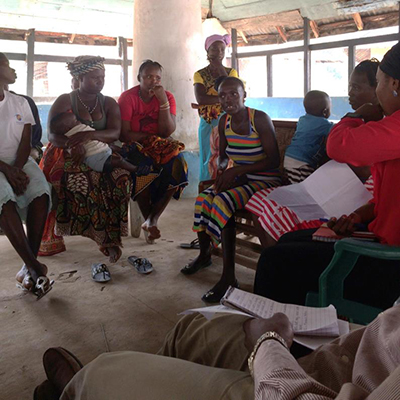
A team of agriculture and nutrition specialists, including SPRING staff and local consultants, analyzed the constraints the value chain actors face in pursuing nutrition-sensitive agriculture by identifying opportunities at each stage of the value chain. Following this exercise, we discussed the findings and recommendations with EAIN stakeholders to determine potential market-based solutions and interventions to promote nutrition-sensitive agriculture. Together, the SPRING and EAIN teams prioritized five recommended nutrition-sensitive agriculture solutions based on their potential impact and fit within EAIN’s work. As a result, SPRING, in collaboration with EAIN partners, defined five priority market-based solutions:
- Gender-equitable access to water for off-season production of nutrient-rich value chain commodities (NRVCCs).
- Training on and access to appropriate technology for on-farm production.
- Training in post-harvest handling and processing.
- Promotion of nutrient-rich value chain commodities to consumers.
- Gender-equitable access and linkages to larger, higher-value buyers to increase household incomes.
Each of these solutions includes illustrative nutrition-sensitive actions and interventions for consideration under the prioritized market-based solution. As a result of this process, EAIN partners incorporated specific actions related to the solutions into their work plans.
Although some of these interventions may not seem like they would contribute to improved nutrition, by helping to improve intermediate outcomes along the “agriculture-to-nutrition program pathways” they can assist in leading to nutrition-sensitive outcomes. A report detailing this work was finalized and disseminated in July 2017.
Listening to Farmers and Mothers
In May 2017, SPRING hosted a webinar titled, “Listening to Farmers and Mothers,” which presented stories on how the combined formative research and nutrition-sensitive agriculture tools led to value-added information for practitioners. Participants heard about results from adapting the value chain approach with a nutrition-sensitive lens, modifying the barrier analysis and TIPs methods to incorporate food security elements, and how SPRING’s integrated approach yielded findings and recommendations that might have been missed had standard approaches been used on their own. The webinar was attended by close to 100 people and was subsequently posted to the SPRING website. A recording is available here.
Best Practices, Challenges, and Recommendations
From our work with the AVCA, SPRING learned that helping partners identify clear nutrition-sensitive agriculture practices helps them ensure that these behaviors are promoted and measured within their respective projects. We would encourage future projects to follow this approach because merging agriculture and health-based formative research tools helps to inform program activities targeting both the agriculture system and household nutrition behaviors. This information would not likely be found by using traditional health and agriculture tools separately. We recommend that future projects also conduct formative research using a similar hybrid approach; adjusting traditional “health-focused” formative research tools (such as barrier analysis and TIPS) to tackle relevant questions beyond the household level and adjusting commonly used “agriculture-focused” methods (such as agriculture value chain analysis) to identify constraints and opportunities for nutrition and not solely for competitiveness.
Although SPRING never established a formal office in Sierra Leone, we were able to work quickly and efficiently through our partnerships. In particular, SPRING was able to build on local partner Helen Keller International’s (HKI) established presence and trust with local organizations and government partners. This allowed us to save time and begin implementing more quickly during the short allotted period.
In FY17, SPRING was tasked providing technical support to help the newly awarded EAIN project build capacity in nutrition-sensitive agriculture. Because SPRING had been active in Sierra Leone for a year and EAIN was just beginning (despite a relatively rapid start up), our ability to provide optimal technical support in the short timeframe was hampered.
Footnotes
1 SMART Survey. 2014. “Sierra Leone Micronutrient Survey.” Freetown, Sierra Leone: MOHS, UNICEF, HKI, and WHO.
2 SMART Survey. 2010. “Report on The Nutritional Situation of Sierra Leone Nutrition Survey Using SMART Methods.” UNICEF.
3 SMART Survey. 2014. “Sierra Leone Micronutrient Survey.” Freetown, Sierra Leone: MOHS, UNICEF, HKI, and WHO.
References
SPRING. 2015. Integrated Nutrition and Agriculture Needs Assessment for Sierra Leone. Arlington, VA: USAID Strengthening Partnerships, Results, and Innovations in Nutrition Globally (SPRING) project.
SPRING. 2017. Sierra Leone: Entry Points for Nutrition in Feed the Future Value Chains. Arlington, VA: Strengthening Partnerships, Results, and Innovations in Nutrition Globally (SPRING) project.
SPRING and HKI. 2017. Shifting Nutrition and Hygiene Behaviors in Sierra Leone Utilizing Trials of Improved Practices. Arlington, VA: Strengthening Partnerships, Results, and Innovations in Nutrition Globally (SPRING) project and Helen Keller International.
SPRING. 2017. Sierra Leone: Barrier Analysis Survey on Fish and Pumpkin. Arlington, VA: Strengthening Partnerships, Results, and Innovations in Nutrition Globally (SPRING) project and Helen Keller International.
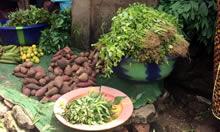
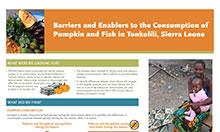
![Page 1 [figure] Coat of arms for Sierra Leone [photos, in center and in upper right] Two different kinds of pumpkin [title] Best Agronomic Practices for Pumpkin [logos] USAID logo: "USAID: United States Agency [for] International Development. USAID. From the American People" SPRING logo: “SPRING. Strengthening Partnerships, Results, and Innovations in Nutrition Globally”](/sites/default/files/publications/tools/thumbs/sl_pumpkin_cards_cover_thumb.jpg)
